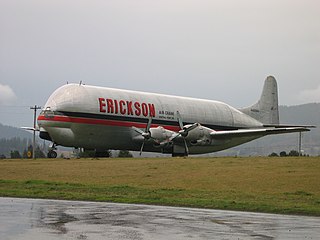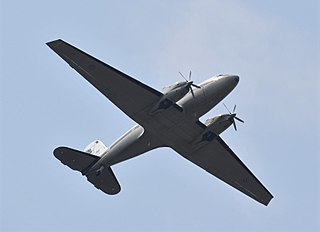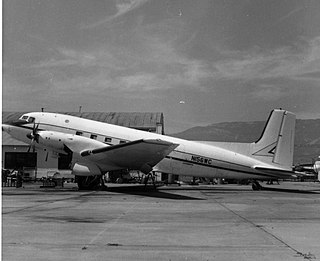
The Douglas DC-3 is a propeller-driven airliner manufactured by Douglas Aircraft Company, which had a lasting effect on the airline industry in the 1930s to 1940s and World War II. It was developed as a larger, improved 14-bed sleeper version of the Douglas DC-2. It is a low-wing metal monoplane with conventional landing gear, powered by two radial piston engines of 1,000–1,200 hp (750–890 kW). Although the DC-3s originally built for civil service had the Wright R-1820 Cyclone, later civilian DC-3s used the Pratt & Whitney R-1830 Twin Wasp engine. The DC-3 has a cruising speed of 207 mph (333 km/h), a capacity of 21 to 32 passengers or 6,000 lbs (2,700 kg) of cargo, and a range of 1,500 mi (2,400 km), and can operate from short runways.

The Bristol Type 175 Britannia is a retired British medium-to-long-range airliner built by the Bristol Aeroplane Company in 1952 to fly across the Commonwealth. During development two prototypes were lost and the turboprop engines proved susceptible to inlet icing, which delayed entry into service while solutions were sought.

The Aero Spacelines Super Guppy is a large, wide-bodied cargo aircraft that is used for hauling outsize cargo components. It was the successor to the Pregnant Guppy, the first of the Guppy aircraft produced by Aero Spacelines. Five were built in two variants, both of which were colloquially referred to as the "Super Guppy".

Aero Spacelines, Inc. was an American aircraft manufacturer from 1960 to 1968 that converted Boeing 377 Stratocruisers into the famous Guppy line of airplanes, re-engineered to transport oversized cargo such as space exploration vehicles.

The Boeing 377 Stratocruiser was a large long-range airliner developed from the C-97 Stratofreighter military transport, itself a derivative of the B-29 Superfortress. The Stratocruiser's first flight was on July 8, 1947. Its design was advanced for its day; its relatively innovative features included two passenger decks and a pressurized cabin. It could carry up to 100 passengers on the main deck plus 14 in the lower deck lounge; typical seating was for 63 or 84 passengers or 28 berthed and five seated passengers.

The Rolls-Royce RB.53 Dart is a turboprop engine designed and manufactured by Rolls-Royce Limited. First run in 1946, it powered the Vickers Viscount on its maiden flight in 1948. A flight on July 29 of that year, which carried 14 paying passengers between Northolt and Paris–Le Bourget Airport in a Dart-powered Viscount, was the first regularly scheduled airline flight by a turbine-powered aircraft. The Viscount was the first turboprop-powered aircraft to enter airline service - British European Airways (BEA) in 1953.

The Grumman HU-16 Albatross is a large, twin–radial engined amphibious seaplane that was used by the United States Air Force (USAF), the U.S. Navy (USN), and the U.S. Coast Guard (USCG), primarily as a search and rescue (SAR) aircraft. Originally designated as the SA-16 for the USAF and the JR2F-1 and UF-1 for the USN and USCG, it was redesignated as the HU-16 in 1962. A new build G-111T Albatross with modern avionics and engines was proposed in 2021 with production in Australia to commence in 2025.

The Grumman G-73 Mallard is a medium, twin-engined amphibious aircraft. Many have been modified by replacing the original Pratt & Whitney Wasp H radial engines with modern turboprop engines. Manufactured from 1946 to 1951, production ended when Grumman's larger SA-16 Albatross was introduced.

A cargo aircraft is a fixed-wing aircraft that is designed or converted for the carriage of cargo rather than passengers. Such aircraft usually do not incorporate passenger amenities and generally feature one or more large doors for loading cargo. Freighters may be operated by civil passenger or cargo airlines, by private individuals or by the armed forces of individual countries.

The Aero Spacelines Pregnant Guppy was a large, wide-bodied cargo aircraft built in the United States and used for ferrying outsized cargo items, most notably components of NASA's Apollo program. The Pregnant Guppy was the first of the Guppy line of aircraft produced by Aero Spacelines. The design inspired later designs, such as the jet-powered Airbus Beluga and Boeing Dreamlifter.

The Conroy Skymonster (CL-44-0) is a 1960s United States specialized cargo aircraft based on the Canadair CL-44 freighter, with an outsize fuselage.

Conair Group Inc. of Abbotsford, British Columbia, Canada, formerly known as Conair Aviation, is a company specializing in retrofitting firefighting aircraft, maintaining customer and company-owned aircraft and aerial firefighting. Conair currently employs over 250 staff and has a fleet of aircraft that are broken down into two categories; air attack, and airtankers. Conair specializes in fire management support by providing services and products to forest protection agencies around the world. In 1996 Conair became a Canadian Air Tractor dealer for the AT-802F air tanker. A former Conair Group division; Cascade Aerospace was acquired by the IMP Group of Halifax, Nova Scotia in 2012.

The Boeing 747-400 Large Cargo Freighter (LCF) is a wide-body cargo aircraft modified extensively from the Boeing 747-400 airliner. With a volume of 65,000 cubic feet (1,840 m3) it can hold three times that of a 747-400F freighter. The outsized aircraft, known as the Dreamlifter, was designed to transport Boeing 787 Dreamliner parts between Italy, Japan, and the U.S., but has also flown medical supplies during the COVID-19 pandemic.

The Basler BT-67 is a utility aircraft produced by Basler Turbo Conversions of Oshkosh, Wisconsin. It is a remanufactured and modified Douglas C-47 (DC3); the modifications are designed to significantly extend the DC-3's serviceable lifetime.

The Conroy Turbo-Three was a series of two Douglas DC-3s modified with turboprop engines by Conroy Aircraft. The first conversion first flew on May 13, 1969. Two Rolls-Royce Dart Mk. 510 engines from a crashed Vickers Viscount previously operated by United Airlines were used to replace the original Pratt & Whitney radial engines. Because the new turboprops were much lighter than the radial engines, they had to be mounted further forward to maintain the aircraft's center of gravity. The replacement engines increased the aircraft's cruising speed from 170 mph to 215 mph. The prototype was later converted into the Conroy Tri-Turbo-Three.

Aero Union Corporation was an aircraft operation and maintenance company based in Chico, California, United States. It was known for operating aerial firefighting aircraft, training crews and making custom designed firefighting systems tailored to specific aircraft requirements. After years of controversies regarding the operation of the company and the safety of its aircraft, the U.S. Forest Service (USFS) canceled its contract, and the company was forced to shut down soon after.

The Conroy Tri-Turbo-Three was a Douglas DC-3 fitted with three Pratt & Whitney Canada PT6A turboprop engines by Conroy Aircraft; the third engine was mounted on the nose of the aircraft.

John Michael Conroy was an American aviator and later businessman, whose company Aero Spacelines developed the Pregnant Guppy, Super Guppy, and Mini Guppy cargo aircraft. He later founded Conroy Aircraft and Specialized Aircraft in Santa Barbara, California.

The Conroy Virtus was a proposed American large transport aircraft intended to carry the Space Shuttle. Designed, beginning in 1974, by John M. Conroy of the Turbo-Three Corporation, it was to incorporate a pair of Boeing B-52 Stratofortress fuselages to form a new craft using existing parts for cost-savings. While the project was seriously considered, it proved impractically large and NASA chose to develop the Boeing 747–based Shuttle Carrier from surplus commercial aircraft instead.



















